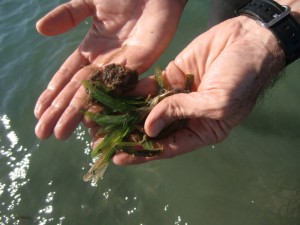Since the 2011 IMARES Wageningen University overview of marine invasive species in the Dutch Caribbean (Debrot et al. 2011), the invasive seagrass Halophila stipulacea has been additionally documented on three additional Dutch islands. While in 2011 it was only known from St. Maarten and Bonaire, it has now been confirmed for Aruba, Curacao and St. Eustatius. It is typically found in habitats protected from wave energy on the lee side of islands either due to depth (down to 26 m depth in St. Eustatius) or in sheltered lagoons. These findings have been incorporated into a regional assessment (Willette et al.) now in press with the journal Aquatic Botany. (I add a photo of me standing in its typical habitat in Curacao, as well as a shot of a handful of the seagrass (coll. October in Curacao).
It appears to be a strong invader and occupies space typically in the form of dense monospecific patches, with coverage typically upwards of 85%. At present, IMARES Wageningen University Research Center is conducting some preliminary evaluations in Bonaire on whether or not the species is consumed by the green turtle and on how it may affect seagrass nursery fish abundance.
In the 10 years since first being documented in the Caribbean, Willette et al (in press) have found that the species has widely spread throughout the eastern Caribbean (19 different islands), and implicate commercial and recreational boat traffic as its most likely means of dispersal.
Read more: Halophila stipulacea (Hydrocharitaceae)

